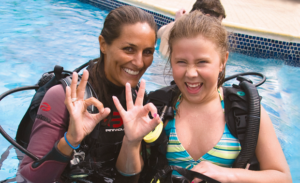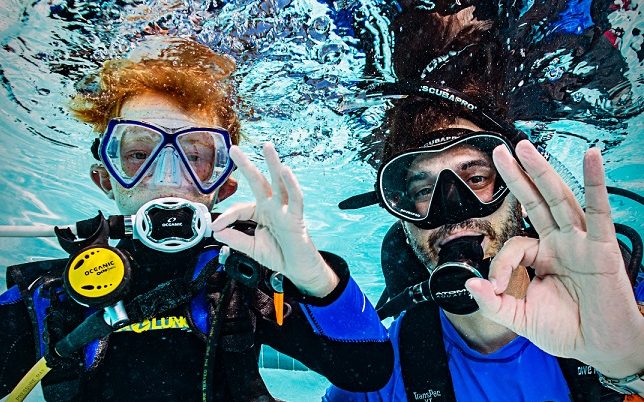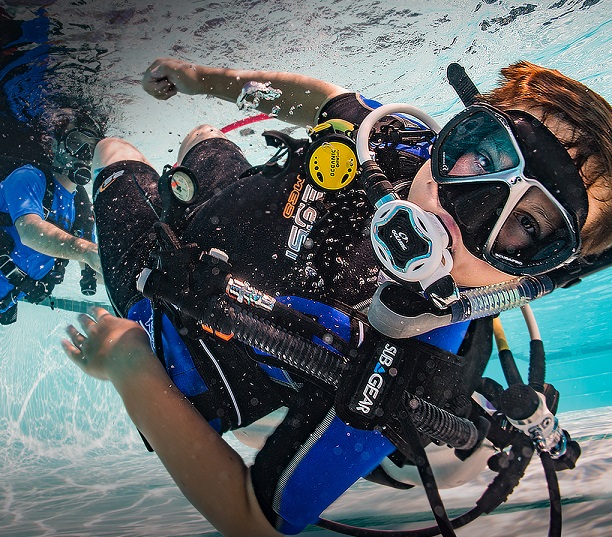Teaching children. Any parent who has been struggling to home-school their child in the pandemic lockdowns will know how tough it is. (Hey, school teachers – remember what we said about you having 6 weeks off every summer? We take it all back – we don’t envy your job!)
But what about teaching kids to scuba dive? That must be awesome! And imagine being able to teach your own kids how to dive. If you are reading this and shaking your head, then you are not alone. Children can be like a different species sometimes and as a dive instructor it’s important to know how to deal with kids so that the experience is a positive one for both parties.
Anyone who knows me knows that I am up for a challenge – blimey, I taught my parents to dive when they were in their seventies! (you can read about my ups and downs on that experience here). But when it came time for my ten-year-old son to take his Open Water Course last year I knew that, as his mum I was going to need help from a more patient non-parent (thanks Moy!)
But teaching children to scuba dive doesn’t have to be a struggle for everyone involved. Even though what we teach to kids will be the same, the way that we teach will be different. So, what are my tips for dive instructors when it comes to teaching children? Having spent my early years as a PADI Instructor on a backpacker island, I don’t have a lot of experience teaching kids. So in preparation for this blog I decided to contact some experts – Gaelle and Johan who did their IDC with The GoPro Family back in 2011. Shortly after completing their IDC with us, they returned to Belgium and set up their own successful dive centre, Planet Octopus, which specializes in teaching diving to children and young adults. With ten years’ experience in this field, Gaelle came up with these awesome 10 tips for teaching children to scuba dive:
Keep briefings brief
The first thing to realize if you want to teach children is that their ability to concentrate is very different from that of adults. As PADI instructors we sometimes want to give very beautiful and elaborate briefings, but with children (especially those between 8 and 10 years old) you cannot ask them for more than 10 or 15 minutes of attention. So it’s super important to choose the information you give them, get straight to the point, and put it into practice immediately. You really have to discuss the essentials with them in the most fun and interactive way possible to keep their attention.
In the water, children play and have fun
Children do not listen when they are in the water. They want to have fun! If you want them to hear your explanations, you should do the briefing out of the water or by the pool.
Children under 8 are not ready to dive
If an age limit is there, it is for good reason. You will always meet a parent who will ask you to make an exception because their child is almost 8 years old or because “he is a good swimmer” or “he is tall for his age” but this is not a good idea. Eight years old [the minimum age for a Bubblemaker or Seal Team experience] is already very young for some children and below this age children do not have the concentration capacity necessary to listen to the instructions, they do not understand the risks and the equipment is not suitable for them. It will be too heavy and uncomfortable. By wanting to please an impatient parent or child, you risk giving them a bad experience which of course goes against what we want.
Teach skills in sequence.
When it comes to safety, the very first thing to teach children is to inflate their BCD on the surface! An adult – even weighted and with an empty BCD – will have the strength in depth to stay on the surface for a moment while swimming. A child will most likely be unable to do so. It is essential to always have one eye on all the children when underwater and ensure that they always inflate their BCD as soon as they reach the surface, so that this action becomes a direct reflex.
Have ways to put kids at ease
A child who asks a thousand questions or makes a lot of noise and disturbs the group will often be the one who is the most nervous. We must therefore try to reassure them rather than seeing him/her as a spoiler. If you can reassure the most worried children and get them to come with you underwater to try this new experience, they are often the ones who do not want to get out of the water at the end!
Consider having toys or a game with you to play underwater, it will help you to put children at ease on their first descent underwater. Their attention will be on the game rather than their worries.
Always have suitable equipment for their size
A BCD or wetsuit that is too large or not tight enough. A tank that is too heavy and makes them lose their balance. A regulator mouthpiece that is too large in the mouth. These might not seem like much when you are an adult but it can very quickly spoil the pleasure of the experience and the child may feel overwhelmed.
A child needs to play in order to learn
With a child, it is impossible to do all the skills without planning moments of play. Remember that they also learn a lot while playing, even if they are not doing the PADI skills. During the games they will acquire greater ease in the water, they will become familiar with the equipment and the new sensations.
Make all parts of the experience a pleasure

When going into open water, remember that all of the scuba gear can be a bit too much to handle. Consider asking parents for help with carrying the equipment if necessary. Getting parents involved in their children’s diving course will also be good for the adults who may have worries or concerns.
Don’t let them get too cold
Be careful, a child cools more quickly than an adult in the water so remember to ask them regularly if they are comfortable. We usually ask children to tell us underwater if they are cold on a scale of #1, #2 or #3. A number 1 is “I’m cold but it’s ok”. Number 2 for “I’m really cold but I can still hold a few minutes” and number 3 for “I can’t take it anymore, I have to stop right away”. When they give us a cold #2 signal we take the path to the exit and we are out of the water before seeing cold #3.
Children live these new experiences with great intensity
Kids will be super excited to make all of these great discoveries, but when under stress or worry they should always feel like they are with someone who is looking out for them and who they can trust. After all, the future of diving is in their hands.
Thanks a lot to Gaelle and Johan for their great advice!
Although children can sometimes seem like a different species, I think we adults are not so different. After all, we were all kids once. In my opinion all instructors would be wise to apply these tips when teaching all recreational diving courses because the grown-ups deserve to have just as much fun as the little ones!

We offer professional level training including PADI Instructor Development Courses in Playa del Carmen, Mexico, as well as recreational, technical, cave diving and freediving.



